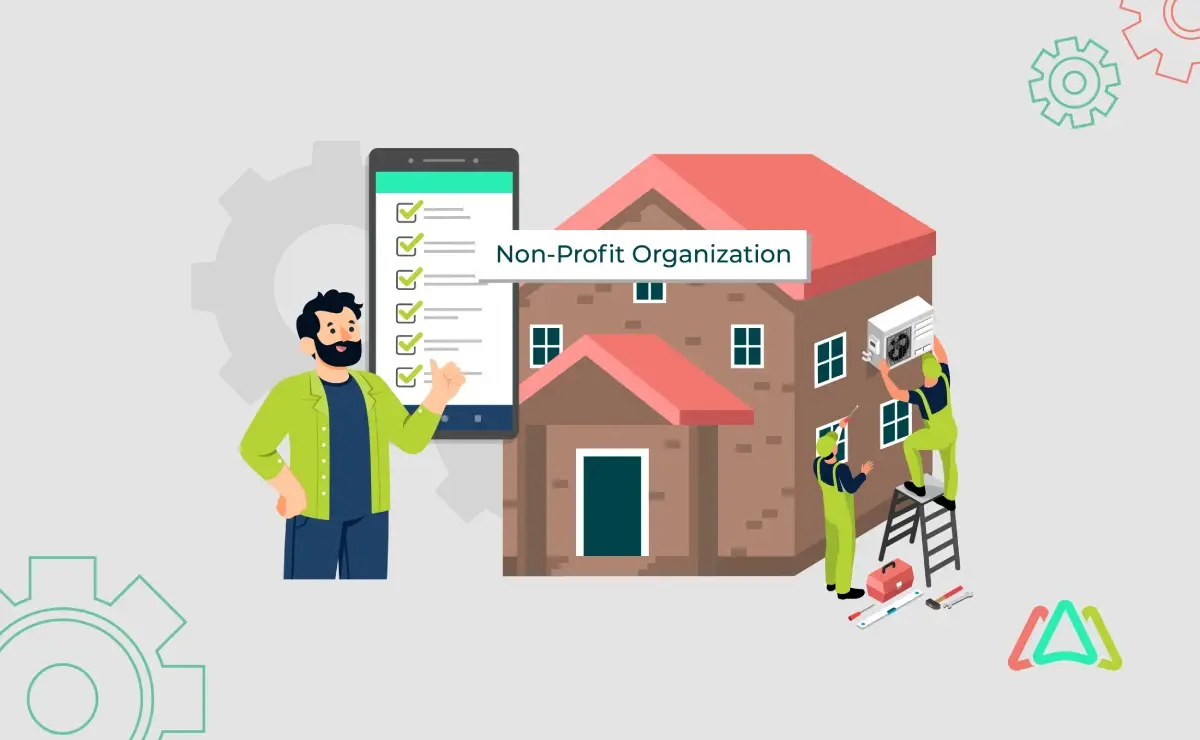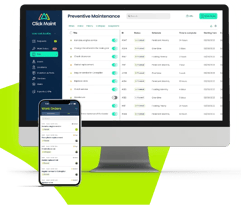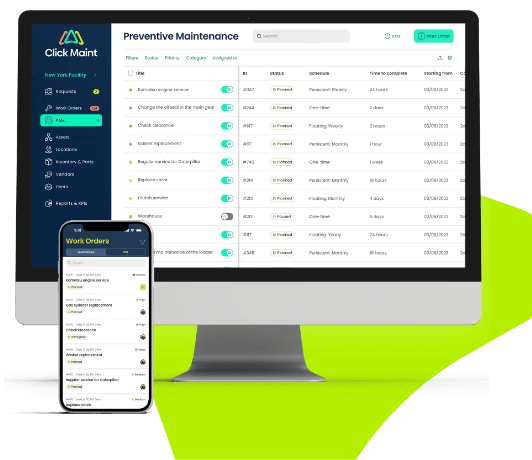
Leveraging CMMS Software to Reduce Maintenance Costs for Non-Profit Organizations
Nonprofit organizations rely heavily on donations and grants to fulfill their mission and provide services to those in need. Because of this, they generally operate on tight budgets, which means they must make strategic decisions to spend every dollar wisely. In other words, nonprofits must maximize every dollar by efficiently managing their resources, including equipment and facility maintenance. Computerized maintenance management systems (CMMS) help nonprofit organizations control costs and run operations within budget.
Maintenance management is often overlooked but critical to any organization's success. Many organizations, including non-profits, assume they cannot afford software to help manage maintenance activities and work orders and, therefore, rely on manual methods that are less efficient, time-consuming, and error-prone. This article offers another perspective, showing that nonprofits that adopt a CMMS as their maintenance management solution find that by doing so, they can streamline maintenance operations, reduce costs, and increase efficiency. All of this fits nicely in meeting their organizations' budgetary requirements.
Beyond helping organizations streamline maintenance processes, a CMMS can track equipment performance, optimize maintenance schedules, and much more. By adopting CMMS, nonprofits can improve operational efficiency, extend the lifespan of their assets, and reduce maintenance costs. This article explores the benefits nonprofit organizations can reap by implementing CMMS software and how it can help them achieve cost-effective maintenance practices.
Streamline managing Work Orders, Preventive Maintenance, and Equipment.
Start your 30-day FREE trial

The Importance of Cost-Effective Maintenance for Nonprofits
Cost-effective maintenance management is crucial for nonprofit organizations looking to optimize their resources and minimize downtime. Adopting a CMMS is an effective way to achieve this.
By implementing a CMMS, nonprofits can streamline maintenance operations, track assets, schedule preventive maintenance tasks, and monitor equipment performance. This proactive approach allows organizations to identify and address issues before they escalate, ultimately reducing repair costs and increasing equipment lifespan.
Additionally, CMMS software provides valuable data and insights that can inform decision-making and help prioritize maintenance activities based on criticality. By tracking labor, inventory, and maintenance costs, nonprofits can optimize their maintenance budget and ensure that funds are allocated efficiently.
Furthermore, CMMS software can help nonprofits comply with regulatory requirements and demonstrate accountability to stakeholders by accurately recording maintenance activities and documenting historical data.
CMMS software can also help nonprofits track and report on their maintenance activities, providing valuable data for grant applications, audits, and annual reports. This transparency can help nonprofits demonstrate their commitment to transparency and accountability, building trust with supporters.
Overall, CMMS software is valuable for nonprofit organizations looking to operate efficiently, responsibly, and transparently. By investing in technology that streamlines maintenance operations and ensures compliance with regulations, nonprofits can focus on their core mission and significantly impact the communities they serve.

Streamline managing Work Orders, Preventive Maintenance, and Equipment.
See how easy Click Maint CMMS is.
How CMMS Software Non-profits Reduce Costs
Computerized Maintenance Management System (CMMS) software can be highly beneficial for non-profit organizations looking to save money at their facilities. By implementing a CMMS, nonprofits can streamline their maintenance operations, increase efficiency, and prolong the lifespan of their assets, all while keeping costs low. Here are ten ways CMMS software can help reduce costs:
1. Preventive Maintenance Scheduling:

CMMS software can schedule preventive maintenance tasks automatically based on equipment usage or time intervals. This helps prevent costly breakdowns and extends the lifespan of equipment.
2. Reduced Downtime:
CMMS software helps reduce unexpected downtime by ensuring equipment and critical assets are well-maintained. This keeps operations running smoothly and avoids the costs associated with emergency repairs and lost productivity.
3. Inventory Management:

CMMS software can track the inventory levels of spare parts and supplies helping inventory management. This prevents overstocking or understocking, minimizes wastage, and ensures you have what you need when maintenance is required.
4. Optimized Labor Management:
Efficient scheduling and assignment of maintenance tasks and work orders through CMMS software can help optimize labor costs. It ensures that maintenance staff and personnel are utilized effectively and reduces overtime by avoiding emergency repairs.
5. Energy Savings:
Some more advanced CMMS systems can integrate with building management systems to optimize energy usage, and some have their own energy management module. By monitoring equipment performance and scheduling maintenance, energy consumption can be reduced, leading to lower utility bills.
6. Compliance and Safety:

CMMS software can help ensure compliance with regulatory requirements and safety standards. This helps facilities managers avoid fines and penalties associated with non-compliance and protects the organization's reputation with the community and donors.
7. Improved Asset Performance:
CMMS software can analyze asset performance trends by asset tracking for historical maintenance data. This insight helps in making informed decisions about repairs, upgrades, or replacements, optimizing asset lifecycle management and costs. Facility managers know when to continue maintaining equipment and when to replace them.
8. Streamlined Communication:
CMMS software centralizes communication related to maintenance tasks and work orders. This reduces misunderstandings, delays, and errors, improving overall operational efficiency and reducing costs associated with reworks.
9. Vendor and Supplier Management:
For services outsourced to third-party vendors, CMMS software can track service agreements, performance metrics, and costs. This ensures that nonprofits get value for money, hold vendors and suppliers accountable, and negotiate better contracts based on historical data.
10. Budget Planning:
CMMS software aids in accurate budget planning by providing detailed maintenance history reports, cost reports, and forecasting tools. This prevents unexpected expenses and allows for better financial management of resources.
CMMS software helps non-profit organizations save money by preventing breakdowns, reducing downtime, optimizing resources, improving energy efficiency, ensuring compliance, and providing data-driven insights for better decision-making. These benefits contribute to overall cost savings and operational efficiency across their facilities.
Adopting a CMMS can empower nonprofits to optimize maintenance operations, improve efficiency, and reduce costs. This allows them to focus more resources on serving their community and fulfilling their mission. By leveraging technology to streamline maintenance practices, nonprofits can achieve long-term sustainability and impact.
Implementing CMMS in Your Nonprofit Organization

Cost-effective maintenance is crucial for nonprofit organizations looking to maximize their resources and ensure the smooth operation of their facilities.
Using a CMMS, nonprofits can streamline maintenance processes, optimize scheduling, and track work orders more efficiently. The software helps reduce downtime and extend the equipment's lifespan, allowing organizations to allocate resources more effectively.
The initial investment in a CMMS may seem daunting, but the long-term cost savings and operational efficiencies far outweigh the upfront costs. By implementing a CMMS, nonprofits can ensure their facilities are well-maintained, reducing the risk of major repairs and unexpected expenses. Additionally, CMMS tools provide valuable data insights to help organizations make data-driven decisions and prioritize maintenance tasks based on criticality and budget constraints.
Many CMMS providers offer affordable pricing plans tailored to nonprofit organizations' needs and budget constraints. By investing in a CMMS system, nonprofits can achieve cost-effective maintenance practices supporting their mission-driven work.
Read our blog on The Top 5 Most Affordable CMMS Solutions to discover innovative maintenance management options to streamline your maintenance operations without breaking the bank.
Incorporating a CMMS can lead to better resource management, increased equipment reliability, and reduced nonprofit operational costs. By investing in a CMMS, organizations can better allocate their limited resources and ensure that their facilities are well-maintained to fulfill their mission and effectively serve their communities.
Maximizing the Benefits of CMMS
Implementing a CMMS in a nonprofit environment can be highly beneficial for cost-effective maintenance. A CMMS allows nonprofit organizations to streamline maintenance processes, increase efficiency, and reduce downtime. Effective maintenance management ultimately leads to cost savings and improved resource allocation.
CMMS software allows organizations to schedule preventive maintenance tasks, track equipment performance, and manage work orders efficiently. By proactively maintaining equipment and assets, nonprofits can avoid costly breakdowns and repairs, saving time and money in the long run.
More specifically, by using CMMS, waiting for equipment to break down before taking action becomes a thing of the past. CMMS allows organizations to schedule regular preventive maintenance tasks based on the manufacturer's recommendations and historical data. By addressing minor issues before they escalate into significant problems, nonprofits can avoid costly repairs and downtime, ultimately saving money in the long run.
CMMSs also help nonprofits keep track of their inventory, spare parts, and maintenance supplies. By maintaining accurate inventory records, organizations can avoid overstocking or running out of critical supplies, leading to cost savings and improved efficiency.
Additionally, CMMS software provides valuable data and insights that help organizations make informed decisions about maintenance strategies and resource allocation. The software provides real-time data and analytics to help nonprofits make informed decisions about their maintenance operations. By analyzing key performance indicators and maintenance metrics, nonprofits can identify trends and indicators pointing to improvement areas. With this critical insight, maintenance managers can optimize their operations for maximum cost-effectiveness.
Adopting a CMMS in a nonprofit organization can lead to significant cost savings, improved maintenance practices, and better resource utilization. It is a wise investment that can help organizations achieve their mission more efficiently and effectively.
Examples of Non-profits Successfully Using CMMS

Use cases help nonprofit organizations understand how to successfully utilize Computerized Maintenance Management Systems (CMMS) to improve their operations. By examining real-world examples of organizations that have effectively implemented CMMS, we can gain insight into the benefits and challenges associated with this technology.
A use case example is a national nonprofit organization that provides housing and support services to low-income individuals and families. By implementing a CMMS system to manage maintenance tasks and scheduling, this organization improved the efficiency of its maintenance staff, reduced downtime due to equipment failures, and ultimately saved on operating costs. This case study is a prime example of how CMMS can streamline operations and drive organizational success in the nonprofit sector.
Another use case example is a local non profit animal shelter that utilized a CMMS to track and schedule maintenance for its facilities and equipment. By implementing a CMMS solution, this organization was able to increase the lifespan of its equipment, minimize costly repairs, and ensure the safety and well-being of the animals in its care. This case study demonstrates how CMMS can be a valuable asset for nonprofit organizations looking to optimize their maintenance processes and resources.
Overall, these use cases highlight CMMS's impact on nonprofit organizations, showcasing the tangible benefits and return on investment that can be achieved through this technology's effective implementation and utilization.
Get your Click Maint CMMS estimate instantly!
Conclusion
A CMMS can be a cost-effective solution for nonprofit organizations looking to improve their maintenance practices. Adopting a CMMS can benefit nonprofit organizations by providing cost-effective maintenance solutions. Utilizing CMMS software allows nonprofits to streamline maintenance processes, reduce costly downtime, and improve operational efficiency.
By implementing proactive maintenance strategies, optimizing inventory management, and leveraging data analytics, nonprofits can increase operational efficiency, reduce maintenance costs, and ultimately better serve their communities. Investing in a CMMS is a smart choice for nonprofits looking to make the most of their limited resources with the greatest impact.
TABLE OF CONTENTS
Keep Reading
Ever find yourself checking into a luxury hotel and expecting a relaxing stay, only to find a ...
11 Apr 2025
Organizations are witnessing swift changes in the business environment and confronting a ...
8 Apr 2025
Last month, news outlets and the entire internet was abuzz with the return of NASA astronauts ...
3 Apr 2025
What comes first - CMMS or predictive maintenance? If your answer is either, it is correct. ...
28 Mar 2025
Artificial intelligence (AI) talk has become commonplace. Today, engaging in business-focused ...
27 Mar 2025
Imagine a world where machines predict, diagnose, and fix their issues before they fail. This ...
25 Mar 2025
A facility maintenance plan is at the core of a facility’s operations. This organized ...
21 Mar 2025
Think of managing your maintenance operations like managing a championship sports team. Just ...
21 Mar 2025
The maintenance sector is battling a severe talent shortage that threatens to undermine ...
7 Mar 2025
Manufacturing maintenance is the backbone of industrial efficiency, ensuring machines run ...
5 Mar 2025
No one likes playing a guessing game when equipment breaks down. Yet, maintenance teams often ...
4 Mar 2025
The size of the preventive maintenance software market is discussed in millions of dollars, ...
4 Mar 2025
The organizational structure and corporate hierarchy vary from company to company. Large ...
28 Feb 2025
Maintenance procedures are essential for ensuring the longevity and reliability of machinery ...
21 Feb 2025
Sustainability is no longer just a buzzword; it's a critical component of corporate social ...
20 Feb 2025
A Computerized Maintenance Management System (CMMS) relies on accurate, well-organized data ...
18 Feb 2025
In an era where technology drives operational efficiency, Computerized Maintenance Management ...
14 Feb 2025
A Computerized Maintenance Management System (CMMS) is a key component of modern maintenance ...
13 Feb 2025
Introduction Maintenance management is the foundation of maintenance operations in industries ...
11 Feb 2025
Introduction A Computerized Maintenance Management System (CMMS) is software designed to help ...
7 Feb 2025






